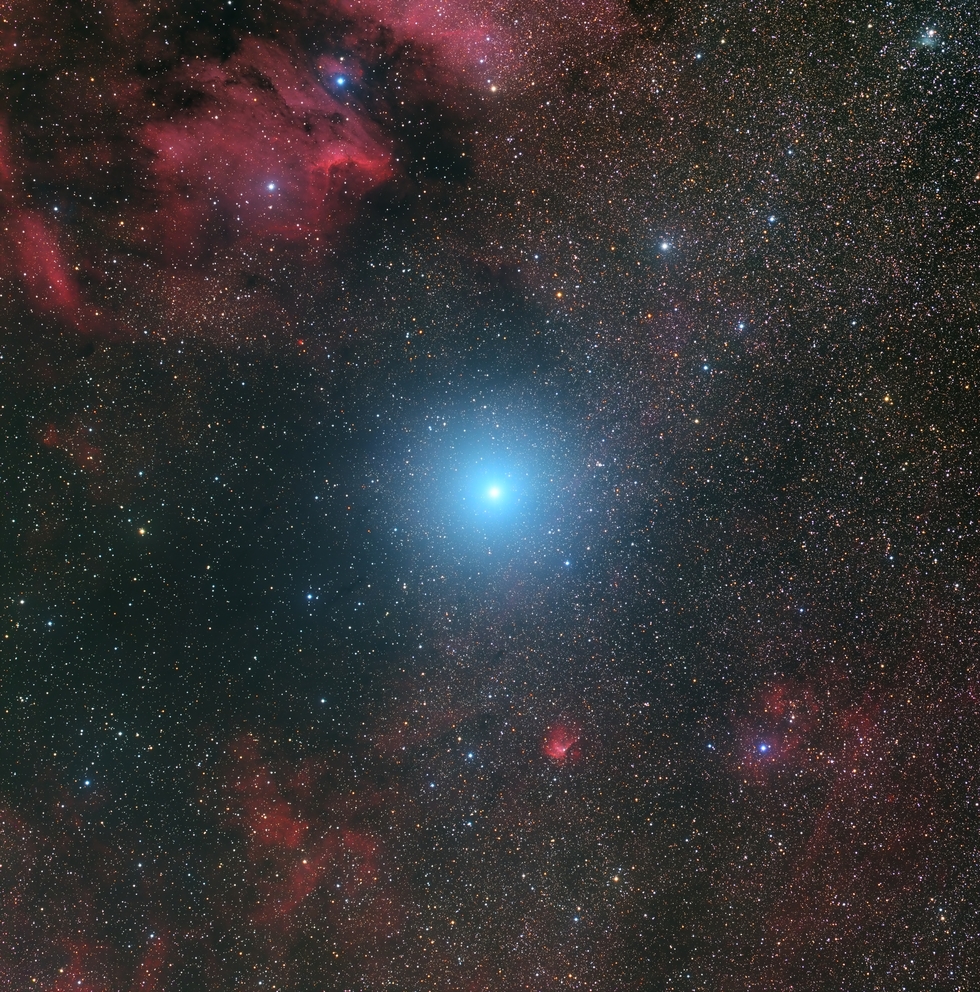Deneb area
Deneb area
Deneb (α Cygni) is the brightest star in the constellation of Cygnus and the 19th brightest in the sky, with an apparent magnitude varying between +1,21 and +1,29. Deneb is one of the stars in the asterism known as the Summer Triangle (it forms it with Vega and Altair).
Due to Earth’s axial precession, Deneb will be an approximate pole star in about 7800 years.
Deneb is a blue supergiant of spectral class A2Ia. The distance to it is quite hard to determine, with ranges varying wildly from 1.400 to 2.600 light-years. Nevertheless, it is the farthest star with an apparent magnitude brighter than +2. In the northern hemisphere, Deneb culminates in the late summer and early autumn evenings. It never dips below the horizon at or above 45° N. Deneb is located at the tip of the Northern Cross asterism, which is made up of the brightest stars in Cygnus (along with Sadr, Albireo, Aljanah and Fawaris).
The spectrum of Deneb has been observed since at least 1888, with an apparent radial velocity indicating a double star. However, in 1935, the work of G. Paddock established that this star was variable due to atmospheric motions on a static core. Its period is 11,7 days and this movement causes variations in the radial velocity. There are also pulsations which add to the irregular light curve this star exhibits.
Deneb is a bluish supergiant with a mass 19 times that of the Sun. The star is so massive, it loses 1 Earth mass every 500 years (or 100.000 times faster than the Sun). Uncertainty about its distance make luminosity estimation tough, but an average value is 130.000 times higher than the solar one. The star is heading towards the end of its life, expanding as it depletes the hydrogen fuel in the core. Its future is uncertain, but astronomers believe it might become a Wolf-Rayet star before exploding as a type I supernova.
Due to Earth’s axial precession, Deneb will be an approximate pole star in about 7800 years.
Deneb is a blue supergiant of spectral class A2Ia. The distance to it is quite hard to determine, with ranges varying wildly from 1.400 to 2.600 light-years. Nevertheless, it is the farthest star with an apparent magnitude brighter than +2. In the northern hemisphere, Deneb culminates in the late summer and early autumn evenings. It never dips below the horizon at or above 45° N. Deneb is located at the tip of the Northern Cross asterism, which is made up of the brightest stars in Cygnus (along with Sadr, Albireo, Aljanah and Fawaris).
The spectrum of Deneb has been observed since at least 1888, with an apparent radial velocity indicating a double star. However, in 1935, the work of G. Paddock established that this star was variable due to atmospheric motions on a static core. Its period is 11,7 days and this movement causes variations in the radial velocity. There are also pulsations which add to the irregular light curve this star exhibits.
Deneb is a bluish supergiant with a mass 19 times that of the Sun. The star is so massive, it loses 1 Earth mass every 500 years (or 100.000 times faster than the Sun). Uncertainty about its distance make luminosity estimation tough, but an average value is 130.000 times higher than the solar one. The star is heading towards the end of its life, expanding as it depletes the hydrogen fuel in the core. Its future is uncertain, but astronomers believe it might become a Wolf-Rayet star before exploding as a type I supernova.
SPECIFICATIONS
Telescope
Takahashi FSQ-106ED f/3,6
Camera
FLI PL16083
Location
Spain
Date of observation
23.04.2024
Filters
LRGB
Processing
PixInsight



